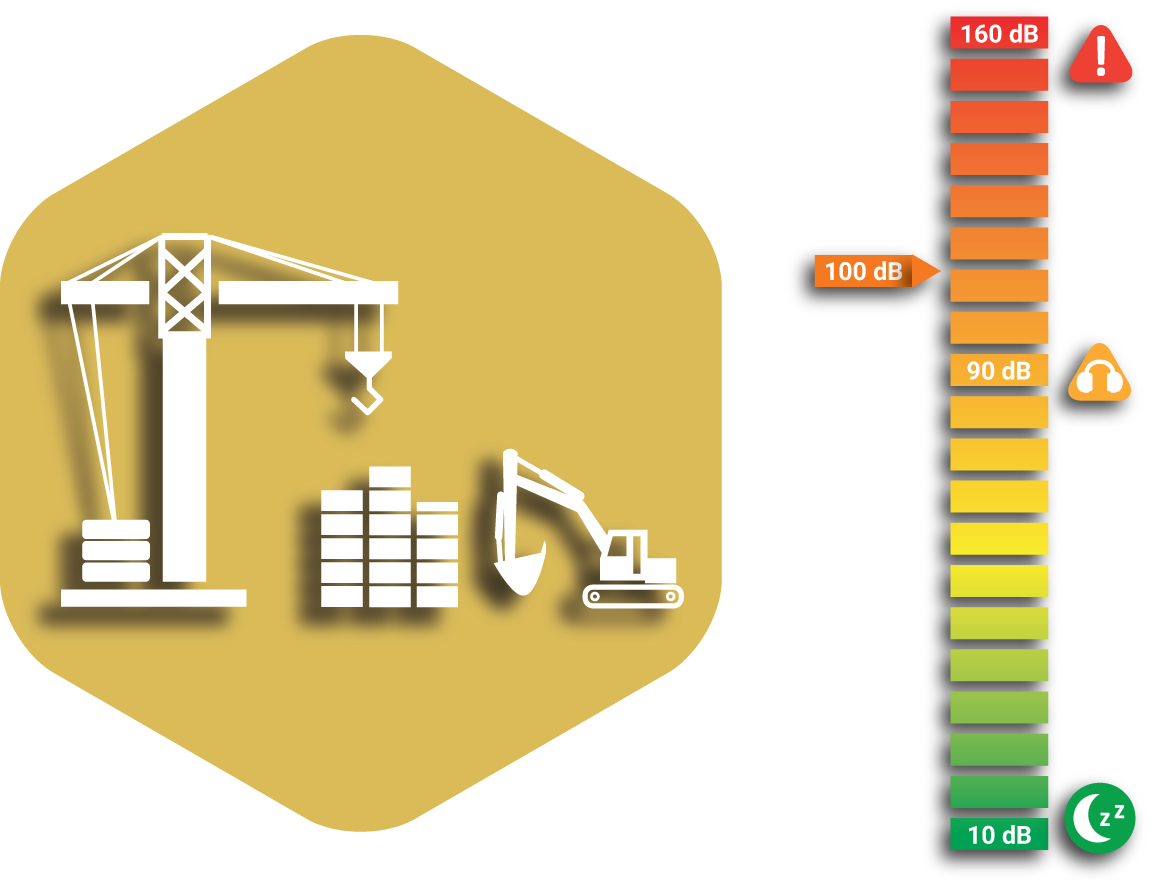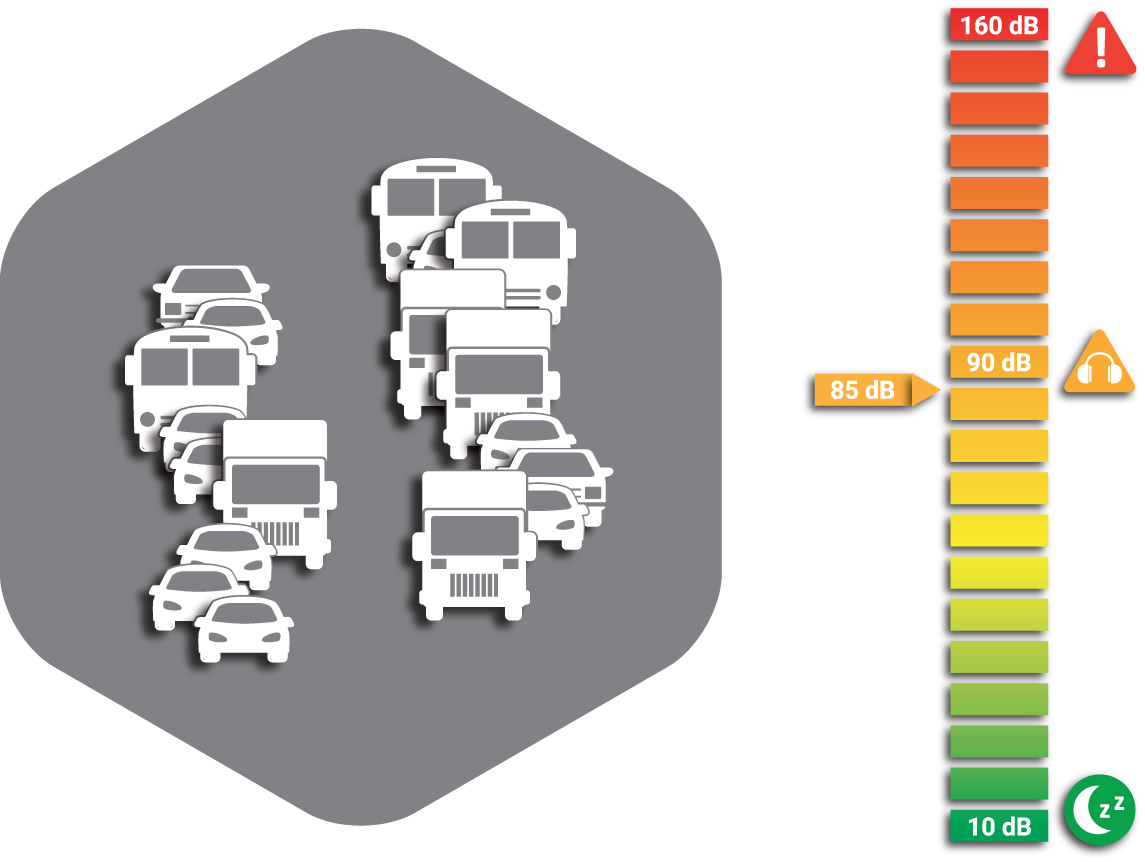Roadwork and Construction Site Noise

Average LEQ: 100 dB(A)
type of construction site: mixed (working machineries & moving vehicles)
distance from the observer: ?15m
Road works and construction sites represent typical noise sources within the urban framework. Most road works are carried out by municipal companies for asphalt and road pavement construction or repairing interventions as well as by utility companies (e.g., gas, electricity, water, telephone, cable services).
Construction works also add inevitable noise contributions to the overall loudness of the urban environment, especially due to their relevant duration in time and the heterogeneity of possible interventions. Citizens can experience noise in different situations: construction of new buildings, renovation of existing buildings, demolition of buildings, installation and/or repairing of utilities.
The noise generated in road and construction sites comes from the superposition of multiple components: machinery and vehicle movements (e.g., cranes, bulldozers, excavators, loaders, bobcats, concrete mixer trucks, etc.), power tools (generators), workers’ equipment (e.g., masonry saws, jackhammers, portable concrete mixers, etc.) and material delivery are the most relevant sources.
Since road and construction works are inevitably noisy, city administrations usually impose specific restrictions on the hours of operations, so that such works cannot normally occurs on Sundays, public holidays, on working days during a specific time interval (7 p.m. – 7 a.m.), provided that special or undelayable interventions are needed.
A series of precautions must be taken whenever it is possible in order to relieve citizenship of noise annoyance, such as: avoiding vehicle movements too close to residential areas; shutting or throttling down machineries and equipment whenever they are not actually in use; adopting noise reduction devices (e.g., mufflers); locating some working or preparatory activities off-site; using semi-permanent structures for noise abatement (e.g., elevations, barriers).
As a reference, we can consider the following SPL average values at 15m from the observer:
- Air compressor: 78 dB(A)
- Concrete Mixer Truck: 85 dB(A)
- Concrete Pump Track: 81 dB(A)
- Crane (moving): 79 dB(A)
- Dump Truck: 76 db(A)
- Excavator: 85 dB(A)
- Flat Bed Truck: 74 dB(A)
- Jackhammer: 90 dB(A)
- Pavement Scarifier: 95 dB(A)
- Pickup Truck: 75 dB(A)
- Pneumatic Tools: 85 dB(A)
- Power Generator: 80 dB(A)
- Refrigerator Unit: 73 dB(A)
- Rivit Buster / Chipping Gun: 80 dB(A)
- Sand Blasting: 96 dB(A)
- Tractor: 84 dB(A)
- Ventilation Fan: 75 dB(A)
- Vibratory Concrete Mixer: 80 dB(A)
- Vibratory/Impact Pile Driver: 100 dB(A)
- Warning Horn: 85 dB(A)
Traffic Noise

Average LEQ: 85 dB
vehicle flow: mixed,
speed: ?50km/h,
distance from the observer: ?15m
This kind of noise is directly originated by multiple components: engine and transmission, rolling tires over the asphalt, aerodynamic, braking systems, additional engines (e.g., radiators, air-conditioners, etc.) and other vehicle-mounted devices (e.g., horns, sirens, bells, whistles, etc.).
In real scenarios, noise levels are given by a mix of heterogeneous traffic conditions: different speed of vehicles, mix of different vehicles types, different vehicle age, etc.
Other variables should also be taken into account, as they contribute to the overall roadway noise levels by their interaction with the vehicles: road surface types (different types of asphalts produce noise levels that can differ up to ±8 dB), roadway geometrics, surrounding terrain and buildings (acoustic waves interact with obstacles according to a series of propagation mechanisms), local weather conditions (wind and temperature gradients can refract waves).
Vehicle speeds affect significantly noise levels: at extremely low speeds, braking and acceleration events are the most significant noise source, whilst at low speeds engines represent the main source of noise. As the vehicle speed increases (beyond 60 km/h), the tires rolling over the asphalt become the loudest source. At very high speed (beyond 150 km/h), aerodynamic noise prevails. The noise from heavy trucks, instead, is mainly due to their engine, both at low and high speeds, since these engines are larger and placed in higher position if compared to other vehicles.
From an acoustic modeling point of view, single vehicles and vehicle flows have to be considered differently. On the one hand, a single and isolated vehicle can be modeled as a point source placed above the road, whose radiated sound energy is shaped as a semisphere centered on the point source, thus the noise decrease is a function of the square of the distance from the source. On the other hand, a flow of vehicles can be represented by a linear source, placed above the road, whose radiated sound energy is shaped as a semi-cylinder coaxial to the linear source, thus the noise decrease is a function of the distance from the source.
As a reference, we can consider the following average values, at 15m from the observer, for speeds not exceeding 50km/h:
- Mixed traffic flow: 85 dB
- Single autobus: 90 dB
- Single heavy truck: 90 dB
- Single van: 80 dB
- Single motorcycle: 85 dB
- Single car: 75 dB
- Single ambulance with siren: 105 dB